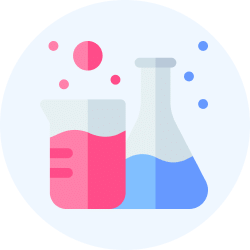Chemistry Exam > Chemistry Questions > How many signals does the unsaturated ketone(...
Start Learning for Free
How many signals does the unsaturated ketone
(CH3)2CHCH2C(O)CH=CH2 have in 1H NMR and 13C NMR spectra?
(CH3)2CHCH2C(O)CH=CH2 have in 1H NMR and 13C NMR spectra?
- a)five 1H signals and six 13C signals
- b)six 1H signals and six 13C signals
- c)six 1H signals and seven 13C signals
- d)five 1H signals and seven 13C signals
Correct answer is option 'B'. Can you explain this answer?
Most Upvoted Answer
How many signals does the unsaturated ketone(CH3)2CHCH2C(O)CH=CH2have ...
Understanding the Structure
The compound in question, (CH3)2CHCH2C(O)CH=CH2, is an unsaturated ketone. To determine the number of signals for both 1H and 13C NMR spectra, we need to analyze its structure and identify the unique environments for hydrogen and carbon atoms.
1H NMR Signals
- The hydrogen atoms can be grouped based on their unique environments:
- **CH3 groups (2)**: The two methyl (CH3) groups attached to the isopropyl carbon contribute **2 signals**.
- **CH2 group (1)**: The methylene (CH2) group adjacent to the carbonyl contributes **1 signal**.
- **H on carbon adjacent to carbonyl (1)**: The hydrogen on the carbon adjacent to the carbonyl (C=O) contributes **1 signal**.
- **Alkenic hydrogens (2)**: The two hydrogens on the alkene (CH=CH2) contribute **2 signals**.
Thus, the total number of unique 1H signals is **6**.
13C NMR Signals
- Now, let’s analyze the carbon atoms:
- **Two CH3 groups**: Each CH3 contributes **1 signal** (total **2 signals**).
- **One CH (connected to the carbonyl)**: This carbon contributes **1 signal**.
- **One CH2 (next to the CH)**: This carbon contributes **1 signal**.
- **One carbonyl carbon (C=O)**: This contributes **1 signal**.
- **Two carbons from the alkene (C=C)**: Each contributes **1 signal** (total **2 signals**).
Thus, the total number of unique 13C signals is **6**.
Conclusion
In summary, the unsaturated ketone (CH3)2CHCH2C(O)CH=CH2 has **6 unique 1H NMR signals** and **6 unique 13C NMR signals**. Therefore, the correct answer is option **B**: six 1H signals and six 13C signals.
The compound in question, (CH3)2CHCH2C(O)CH=CH2, is an unsaturated ketone. To determine the number of signals for both 1H and 13C NMR spectra, we need to analyze its structure and identify the unique environments for hydrogen and carbon atoms.
1H NMR Signals
- The hydrogen atoms can be grouped based on their unique environments:
- **CH3 groups (2)**: The two methyl (CH3) groups attached to the isopropyl carbon contribute **2 signals**.
- **CH2 group (1)**: The methylene (CH2) group adjacent to the carbonyl contributes **1 signal**.
- **H on carbon adjacent to carbonyl (1)**: The hydrogen on the carbon adjacent to the carbonyl (C=O) contributes **1 signal**.
- **Alkenic hydrogens (2)**: The two hydrogens on the alkene (CH=CH2) contribute **2 signals**.
Thus, the total number of unique 1H signals is **6**.
13C NMR Signals
- Now, let’s analyze the carbon atoms:
- **Two CH3 groups**: Each CH3 contributes **1 signal** (total **2 signals**).
- **One CH (connected to the carbonyl)**: This carbon contributes **1 signal**.
- **One CH2 (next to the CH)**: This carbon contributes **1 signal**.
- **One carbonyl carbon (C=O)**: This contributes **1 signal**.
- **Two carbons from the alkene (C=C)**: Each contributes **1 signal** (total **2 signals**).
Thus, the total number of unique 13C signals is **6**.
Conclusion
In summary, the unsaturated ketone (CH3)2CHCH2C(O)CH=CH2 has **6 unique 1H NMR signals** and **6 unique 13C NMR signals**. Therefore, the correct answer is option **B**: six 1H signals and six 13C signals.

|
Explore Courses for Chemistry exam
|

|
Question Description
How many signals does the unsaturated ketone(CH3)2CHCH2C(O)CH=CH2have in1H NMR and13C NMR spectra?a)five1H signals and six13C signalsb)six1H signals and six13C signalsc)six1H signals and seven13C signalsd)five1H signals and seven13C signalsCorrect answer is option 'B'. Can you explain this answer? for Chemistry 2025 is part of Chemistry preparation. The Question and answers have been prepared according to the Chemistry exam syllabus. Information about How many signals does the unsaturated ketone(CH3)2CHCH2C(O)CH=CH2have in1H NMR and13C NMR spectra?a)five1H signals and six13C signalsb)six1H signals and six13C signalsc)six1H signals and seven13C signalsd)five1H signals and seven13C signalsCorrect answer is option 'B'. Can you explain this answer? covers all topics & solutions for Chemistry 2025 Exam. Find important definitions, questions, meanings, examples, exercises and tests below for How many signals does the unsaturated ketone(CH3)2CHCH2C(O)CH=CH2have in1H NMR and13C NMR spectra?a)five1H signals and six13C signalsb)six1H signals and six13C signalsc)six1H signals and seven13C signalsd)five1H signals and seven13C signalsCorrect answer is option 'B'. Can you explain this answer?.
How many signals does the unsaturated ketone(CH3)2CHCH2C(O)CH=CH2have in1H NMR and13C NMR spectra?a)five1H signals and six13C signalsb)six1H signals and six13C signalsc)six1H signals and seven13C signalsd)five1H signals and seven13C signalsCorrect answer is option 'B'. Can you explain this answer? for Chemistry 2025 is part of Chemistry preparation. The Question and answers have been prepared according to the Chemistry exam syllabus. Information about How many signals does the unsaturated ketone(CH3)2CHCH2C(O)CH=CH2have in1H NMR and13C NMR spectra?a)five1H signals and six13C signalsb)six1H signals and six13C signalsc)six1H signals and seven13C signalsd)five1H signals and seven13C signalsCorrect answer is option 'B'. Can you explain this answer? covers all topics & solutions for Chemistry 2025 Exam. Find important definitions, questions, meanings, examples, exercises and tests below for How many signals does the unsaturated ketone(CH3)2CHCH2C(O)CH=CH2have in1H NMR and13C NMR spectra?a)five1H signals and six13C signalsb)six1H signals and six13C signalsc)six1H signals and seven13C signalsd)five1H signals and seven13C signalsCorrect answer is option 'B'. Can you explain this answer?.
Solutions for How many signals does the unsaturated ketone(CH3)2CHCH2C(O)CH=CH2have in1H NMR and13C NMR spectra?a)five1H signals and six13C signalsb)six1H signals and six13C signalsc)six1H signals and seven13C signalsd)five1H signals and seven13C signalsCorrect answer is option 'B'. Can you explain this answer? in English & in Hindi are available as part of our courses for Chemistry.
Download more important topics, notes, lectures and mock test series for Chemistry Exam by signing up for free.
Here you can find the meaning of How many signals does the unsaturated ketone(CH3)2CHCH2C(O)CH=CH2have in1H NMR and13C NMR spectra?a)five1H signals and six13C signalsb)six1H signals and six13C signalsc)six1H signals and seven13C signalsd)five1H signals and seven13C signalsCorrect answer is option 'B'. Can you explain this answer? defined & explained in the simplest way possible. Besides giving the explanation of
How many signals does the unsaturated ketone(CH3)2CHCH2C(O)CH=CH2have in1H NMR and13C NMR spectra?a)five1H signals and six13C signalsb)six1H signals and six13C signalsc)six1H signals and seven13C signalsd)five1H signals and seven13C signalsCorrect answer is option 'B'. Can you explain this answer?, a detailed solution for How many signals does the unsaturated ketone(CH3)2CHCH2C(O)CH=CH2have in1H NMR and13C NMR spectra?a)five1H signals and six13C signalsb)six1H signals and six13C signalsc)six1H signals and seven13C signalsd)five1H signals and seven13C signalsCorrect answer is option 'B'. Can you explain this answer? has been provided alongside types of How many signals does the unsaturated ketone(CH3)2CHCH2C(O)CH=CH2have in1H NMR and13C NMR spectra?a)five1H signals and six13C signalsb)six1H signals and six13C signalsc)six1H signals and seven13C signalsd)five1H signals and seven13C signalsCorrect answer is option 'B'. Can you explain this answer? theory, EduRev gives you an
ample number of questions to practice How many signals does the unsaturated ketone(CH3)2CHCH2C(O)CH=CH2have in1H NMR and13C NMR spectra?a)five1H signals and six13C signalsb)six1H signals and six13C signalsc)six1H signals and seven13C signalsd)five1H signals and seven13C signalsCorrect answer is option 'B'. Can you explain this answer? tests, examples and also practice Chemistry tests.

|
Explore Courses for Chemistry exam
|

|
Signup for Free!
Signup to see your scores go up within 7 days! Learn & Practice with 1000+ FREE Notes, Videos & Tests.


















